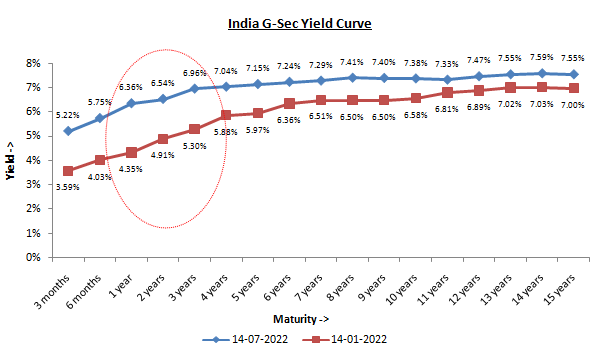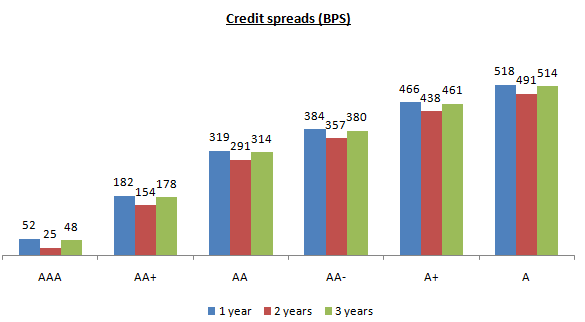Should you invest in short term funds?

Short term funds, also known as short duration funds, are debt mutual fund schemes which invest short term debt and money market instruments like corporate bonds, commercial papers, certificates of deposits, short term Gilts etc.
As per SEBI’s mandate the average Macaulay Duration of the short duration funds should be from 1 year to 3 years. Short term or short duration funds have the potential of giving higher returns than money market mutual funds. At the same time, it has lower interest rate risk compared to medium and long duration debt funds.
Current interest rate and debt market scenario
The debt market has been affected by high inflation over past 12 months or so, with bond yields pushing higher. To cool inflation, Reserve Bank of India (RBI) has raised repo rate by 90 bps already this year. As per RBI data (as on 1st July 2022), the 10 year Government bond yield has risen more than 100 bps on a year on year basis. Rising interest rates have a negative effect on bond prices; longer duration bonds are affected more by interest rate changes. Longer duration debt funds have been underperforming in this interest rate environment.
Recent CPI inflation data (June data) indicates that retail inflation (7.01% in June) is still much above RBI’s tolerance band of 2 – 6%. More rate hikes by RBI are expected in the coming months and quarters. Bonds have factored in future rate hikes by the RBI in prices and yields. The current 10 year bond yield is at 7.42%, which is still below the historical high. However, commodity price inflation is showing signs of cooling especially in commodities like food, oil and gas, metals etc.
US interest rates and bond market
Historically Indian debt markets have been affected by interest rate movements in the US. Inflation is higher in the US than in India, with June inflation in the US spiking up to 9.1%. The Federal Reserve (Fed) has adopted a hawkish monetary policy stance and hiked interest rates by 75 bps already this year. The 1 year US Treasury yield is up by 314 bps in the last 1 year, while the 10 year US Treasury yield is by 162 bps (source: Bloomberg). As per June data, US inflation has reached a 40 year high (source: Wall Street Journal) and more rate hikes may be needed than what the bond markets were anticipating. This may push bond yields even higher in the United States. US Treasury bond is considered to be safest asset class by global institutional investors. If US bond yields go higher, it will cause depreciation of INR and force our bond yields to go higher as well.
What should conservative investors do?
Conservative investors in India have traditionally favoured bank FDs and Government small savings schemes. Bank FD and Government small savings interest rates have shown secular decline over the past 20 years or so. Low interest rates have caused investors to look at other investment options especially debt mutual funds, which have the potential of outperforming bank FDs and Government small savings schemes over similar investment tenures. While banks have increased deposit rates over the past few months, it is still on the lower side of expectations of investors, given current inflation rate. 1 year to 3 year FD interest rates of major public and private sector banks are in the range of 5.3 to 5.5%. Investors, who are not looking for assured returns, can get potentially higher returns by investing in short duration debt mutual funds.
Short term yields are attractive now
While rising bond yields cause volatility, it can create attractive investment opportunities for short term investors. The chart below shows the Government bond yield curve in India. Yield curve shows the yield of bonds of different maturities. You can see that in the last six months, yields got raised more in the 1 to 3 year maturity range of the yield curve (see the region of the yield curve circled in red) compared to other part of the yield curve. The 1 to 3 year G-Sec yields are in the range of 6.36% to 6.96%, which are much higher than traditional fixed income interest rates for similar tenures. Short duration funds invest in debt and money market instruments, such that their Macaulay Duration is between 1 to 3 years; these funds have the potential of giving higher returns than traditional fixed income investments over sufficiently long investment tenures.

Source: Worldgovernmentbonds.com, as on 14th July 2022. Disclaimer: Past performance may or may not be sustained in the future.
Credit Spreads are attractive
Short duration funds invest in debt or money market instruments like corporate bonds (NCDs), commercial papers (CPs), certificates of deposits (CDs) etc which are issued by private and public sector issuers. In addition, they also invest in instruments issued by the Central Government (G-Secs), State Governments (SDLs). The yields on instruments issued by private sector issuers are higher than Central and State Government bonds. The difference in yield of a debt or money market instrument of a non Government and Government issuer is known as credit spreads. Current credit spreads for AAA rated bonds (highest credit rating) is around 25 to 50 bps points in 1 to 3 year maturity tenures; in other words, you will get 25 to 50 bps higher yield over and above G-Secs (shown in the yield curve above) by investing in AAA bonds. Slightly lower rated bonds can give even higher yields (see the chart below). You should invest according to your risk appetite; check the SID or scheme factsheet and make informed investment decisions.

Source: CRISIL, as on 30th June 2022. Disclaimer: Past performance may or may not be sustained in the future.
Interest rate risk
Short term funds or short duration funds are subject to interest rate risks. Interest rate risk is directly related to duration. Higher the duration, higher is the interest rate risk. For example, if the duration of a fund is 10 years, then for every 50 bps of interest rate change, the price will fall by 5%. On the other hand, if the duration of the fund is 2 years, then for every 50 bps of interest rate change, the price will fall by 1%. The duration of short term or short duration funds is 1 to 3 years; so interest rate risk is relatively low compared to medium and long duration funds.
No interest rate risk if bonds are held till maturity
Though interest rate risk of short duration funds is relatively low, short duration funds can be volatile in the short term i.e. they can give negative returns over a few days, weeks etc. However, there is no interest rate risk, if a bond is held till maturity. Even if the price of bond changes in the interim, on maturity of the bond you will get the face value of the bond. So interest rate changes have affect on bond returns if they are held till maturity; despite change in interest rates, you still get the interest and principal on maturity. Short duration funds employ accrual strategy; in other words, they hold the bonds till maturity to accrue the interest paid by the bonds and get the face value on maturity. Therefore, it is important that your investment tenure should be at least the same as the duration of your short term fund or short duration fund or longer. We suggest that you have minimum 3 year investment tenures in this fund in the current interest rate scenario.
Gains from re-investment in rising interest scenario
Short duration funds invest in debt and money market instruments, such that the duration of the scheme is between 1 and 3 years. Some instruments (of shorter maturity) in the scheme’s portfolio may mature before other instruments (of longer maturity) in the scheme portfolio. The advantage of short duration funds in a rising interest rate environment is that they can re-invest the maturity proceeds of an instrument in a higher yielding instrument. This can give you higher returns over sufficiently long investment tenures.
Summary - Why invest in short term funds now?
- Interest rates of traditional fixed income investment options (e.g. Bank FDs, Government Small Savings Schemes) are still relatively low on a post tax, inflation adjusted basis.
- Short term bond yields in the 1 to 3 year maturity range of the G-Sec yield curve are attractive compared to traditional fixed income investments.
- Current credit spreads of high quality bonds (AAA / AA rated papers) are also attractive.
- Conservative investors can invest in short term or short duration funds to capture these attractive yields over 3 year investment tenures.
- Over 3 years plus investment tenures, you can get benefits of long term capital gains taxation. Long term capital gains in debt funds are taxed at 20%, after allowing for indexation benefits. Long term capital gains taxation is beneficial for investors in higher tax brackets.
- You should ensure that your investment tenure matches with the maturity / duration of the scheme, so that you can minimize interest rate risk.
- You should check the credit quality profile of the scheme before investing; invest according to your risk appetite and consult with your financial advisor if you need any help.
Mutual Fund Investments are subject to market risk, read all scheme related documents carefully.
RECOMMENDED READS
The information being provided under this section 'Investor Education' is for the sole purpose of creating awareness about Mutual Funds and for their understanding, in general. The views being expressed only constitute opinions and therefore cannot be considered as guidelines, recommendations or as a professional guide for the readers. Before making any investments, the readers are advised to seek independent professional advice, verify the contents in order to arrive at an informed investment decision.
Mutual Fund investments are subject to market risks, read all scheme related documents carefully.
Quick Links
Follow Nippon India MF
More About Nippon India MF
POST A QUERY






